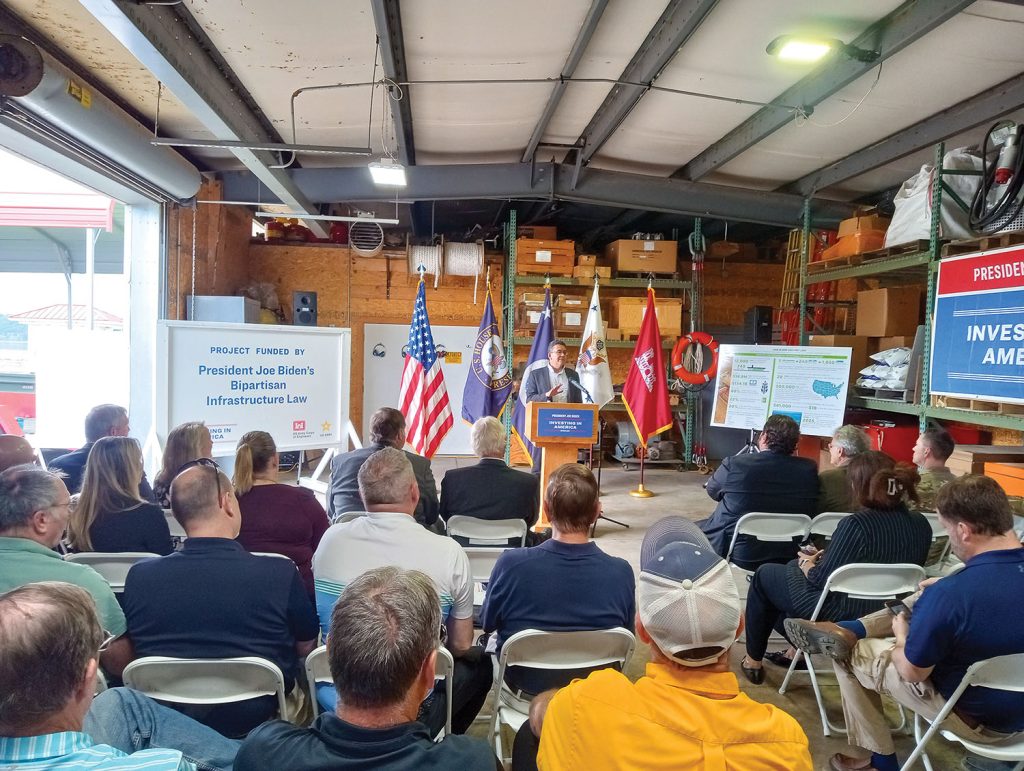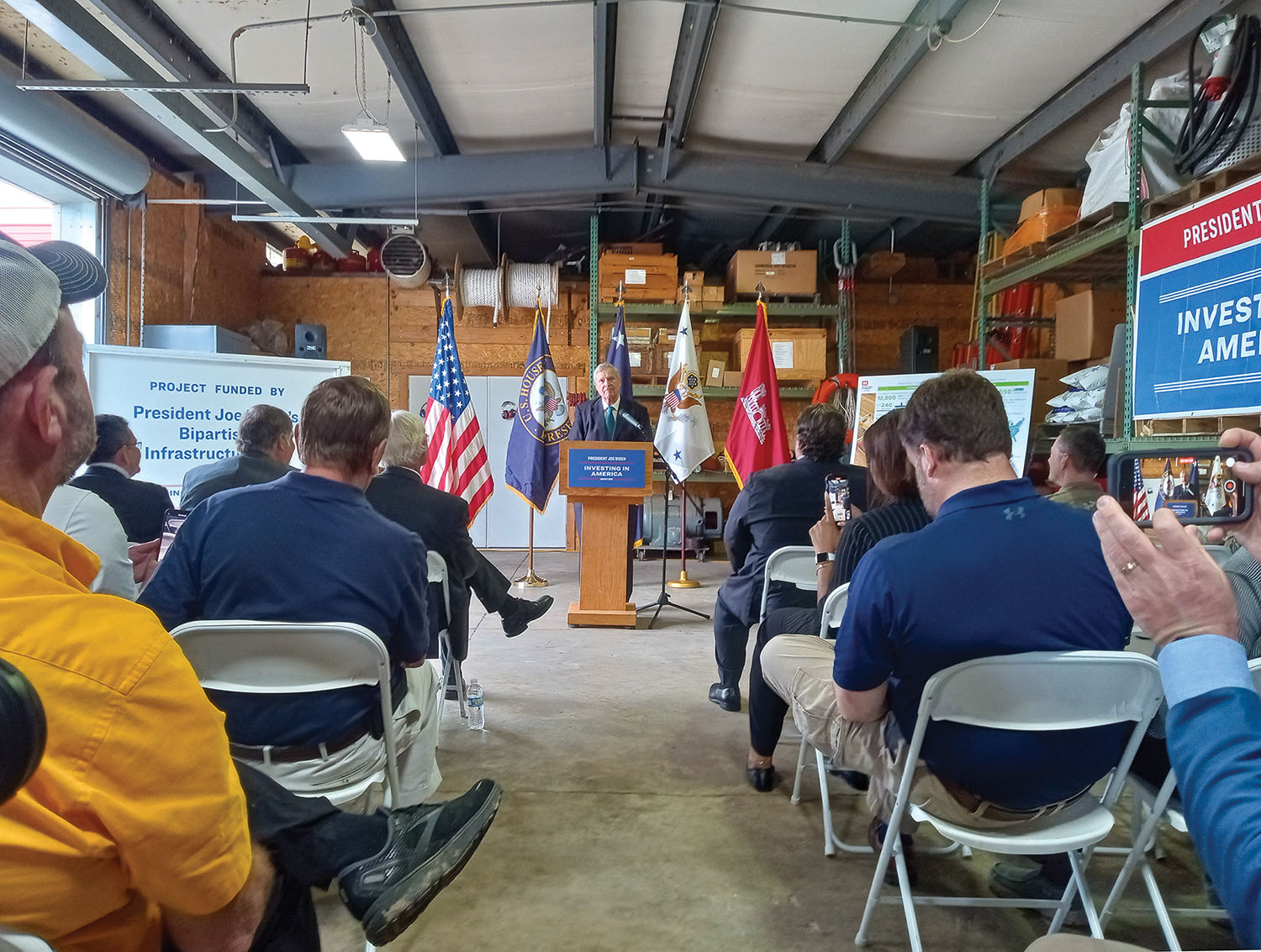In an event organized by the U.S. Department of Agriculture, Secretary of Agriculture Tom Vilsack and Assistant Secretary of the Army-Civil Works Michael Connor visited Lock and Dam 25 in Winfield, Mo., on May 3 to tout the accomplishments of President Joe Biden’s infrastructure agenda.
Speakers included Ken Hartman Jr., a vice president of the National Corn Growers Association and a farmer whose farm is near the Mississippi River. He noted that 60 percent of all U.S. grain exports travel to the Gulf via the Mississippi River, as well as fertilizer and other ag inputs coming upriver. “It’s essential that river systems be maintained to keep our ag exports competitive,” he said.
Competitive Edge
Stan Born, a soybean and corn grower from Lovington, Ill., and a director of the U.S. Soybean Export Council, said his farm was 200 miles from Winfield. Lock and Dam 25, which is getting a 1,200-foot chamber to supplement its aging 600-foot chamber, is a “crucial juncture” for U.S. grain exports, he said. U.S. farmers grow the “highest quality” soybeans and corn, and America’s riverine transportation system gives exporters a competitive edge. But “our competitors are investing fast” in their own river infrastructure, he said, noting that he just returned from a trip to Brazil, the world’s leading soy exporter. Born noted that “the sausage-making [i.e., lawmaking] is more difficult in Washington than on the farm.” He called for “relentless diligence” in maintaining U.S. lock and dam infrastructure.
Connor thanked the farmers present for their “helpful advocacy,” and he noted that he didn’t have a lot of experience in the navigation side when he became assistant secretary. America’s waterways “are a crown jewel of our transportation system” that saves American exporters between $7 billion and $9 billion a year, “But it’s a hidden jewel,” he said.
In the past four years, he said, thanks to the Infrastructure Investment and Jobs Act and the Inflation Reduction Act, “We’ve seen an unprecedented amount of investment” in transportation infrastructure—$4 billion in total investment, of which $2.5 billion went to the inland waterways.
He cited 11 waterways projects that are in some form of construction activity, fully funded and moving forward. One of these is the $100 million fish passage located at Lock and Dam 22, north of Winfield, an example of the environmental benefits of the Navigation and Ecosystem Sustainability Program that is also funding Lock and Dam 25’s new 1,200-foot chamber. “The beauty of NESP is that it’s not one-sided,” Connor said. He said there is another $500 million for waterways in a bill now moving through Congress.

Next, Rep. Nikki Buzinski spoke. She represents Illinois’ 13th congressional district and is a member of key agricultural committees, including the House Committee on Agriculture and the Subcommittee on General Farm Commodities.
“Family farmers in Illinois and Missouri rely on the Mississippi River to move our corn and soybeans to market,” Buzinski said. “It gives us a leg up, but infrastructure does not last forever. These locks and dams were built for the steamship age 90 years ago! Breaking up and reforming tows [for the 600-foot chamber] is one of the most difficult and dangerous jobs on the rivers. I will continue to advocate for sustained investments in lock and dam infrastructure.”
Vilsack Reflects On Waterway History
Vilsack joked that there was little left to say, but he reflected on America’s long history of waterways development, going back to the Erie Canal. “There was skepticism of that project at first, but it made a real difference” in American trade patterns, he said. About 90 years later, Lock and Dam 25 was built, during the Depression.
To show the importance of ag exports, Vilsack noted that in the past three months, the U.S .trade deficit with the rest of the world was about $6 billion—which is almost exactly equal to the amount that soybean sales to China have fallen off. Projects like the adding of a 1,200-foot chamber at Lock and Dam 25 “are putting back our competitive edge,” he said. He spoke of the recent creation of the 36-billion-gallon renewable fuel industry and said the Inflation Reduction Act is helping to “create a low-carbon future for transportation.”
Vilsak noted that military recruits come disproportionately from rural areas, and he thanked the Corps of Engineers for helping to ensure national security through food security. “Each of us that doesn’t have to farm and can pursue our dreams has delegated that responsibility to growers and the Corps of Engineers. We are a food-secure nation because of them.”
Caption for top photo: U.S. Agriculture Secretary Tom Vilsack speaks at Lock and Dam 25. (Photo by David Murray)




